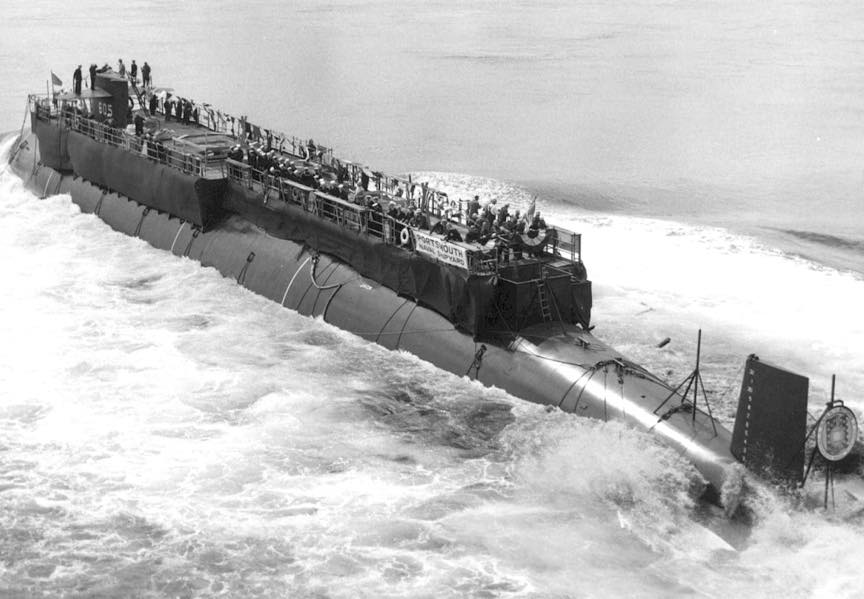Jack II SS(N)-605

Jack II
(SS(N)-605: dp~ 3, - 8 (surf.), 1. 278'; b. 31'7", dr.
25'4"; s. classified; cpl. 95; a. 4 tt.; cl. Thre~her)
The second Jaek (SSX 605) was laid down 16 September 1960 by Naval Shipyard, Portsmouth, N.H; launched 24 April 1963, sponsored by Mrs. Leslie R. Groves, wife of Lieutenant General Groves, head of the Manhattan Project; and commissioned 31 March 1967, Comdr. L. T. Urbanezyk in command.
She then joined the Atlantic Fleet and operates out of New London, Conn., as one of the Navy's fast and versatile nuclear submarines, a mighty weapon helping to assure the United States control of the seas.
In September and October 1968, the North Atlantic Treaty Organization (NATO) held Exercise Silver Tower, its largest combined naval exercise since 1964. The exercise – one of a series of major maritime exercises designed to test NATO plans and defenses under simulated battle conditions – brought together aircraft and about 200 ships from Belgium, Canada, Denmark, the Netherlands, Norway, Portugal, the United Kingdom, the United States, and West Germany, including destroyers and frigates from NATO's new multinational Standing Naval Force Atlantic. Soviet Navy ships shadowed the exercise, which depicted an imaginary threat to Norway posed by political and military pressure from an adversary nation called "Orange." During Silver Tower, Jack very successfully demonstrated the capabilities of a modern nuclear submarine, playing the role of an "Orange" submarine opposing both underway replenishment groups and a large aircraft carrier task force, and she claimed a simulated sinking tonnage of 319,000 displacement tons; during all of World War II, the three top-scoring United States Navy submarines – USS Flasher (SS-249), USS Rasher (SS-269), and USS Tang (SS-306) – had sunk a combined total of just over 293,956 gross register tons of enemy merchant shipping and displacement tons of enemy warships. After the exercise, when key representatives from each participating ship assembled in the United Kingdom at Rosyth Dockyard in Rosyth, Scotland, for a presentation of the results of the exercise, Jack received special mention as a result of her outstanding performance during the exercise.[citation needed]
After the conclusion of Silver Tower, Jack returned to Portsmouth Naval Shipyard late in 1968 for a four-month post-shakedown shipyard availability.
1969[edit]
Completing the availability in March 1969, Jack participated in a Caribbean training exercise, Exercise Springboard. As a result of Jack's performance during the exercise, her weapons department was awarded the Battle Efficiency "E" for fire control excellence.[citation needed]
Later in 1969, Jack was assigned a secret special operation. The performance of the crew during that operation resulted in the following letter from the Chief of Naval Operations:[citation needed]
<quoteblock> "The Secretary of the Navy takes pleasure in presenting the Meritorious Unit Commendation to USS JACK (SSN-605) for service as set forth in the following CITATION:
"For meritorious service during a period in 1969 in conducting an important and arduous independent submarine operation. In successfully completing the operation, USS JACK achieved significant results of great importance to the national defense of the United States. These results were attained primarily through the professional skills, resoursefulness, and teamwork of USS JACK's officers and men. Their dedication to the fulfillment of a vital and difficult assignment reflects credit upon themselves and the United States Naval Service. All personnel attached to and servind on board USS JACK (SSN-605) during the period of this citation are hereby authorized to wear the Meritorious Unit Commendation Ribbon.
"For the Secretary, /s/ T. H. Moorer, Admiral, United States Navy, Chief of Naval Operations."
Jack later received a second Meritorious Unit Commendation.[when?][citation needed] On 26 June 1969 Jack tested the performance of an armed Mark 16 torpedo by sinking a target ship, the decommissioned destroyer escort USS Snowden (DE-246)
During the summer of 1970, while Jack was engaged in midshipmen training at the United States Naval Academy in Annapolis, Maryland, she was awarded the Battle Efficiency "E" by Commander, Submarine Force, Atlantic
1971[edit]
On 11 February 1971, Jack arriveed at the Portsmouth Naval Shipyard to begin an extensive, 12-month overhaul.[citation needed]
In early 1972, toward the end of her overhaul, the United States Atlantic Fleet's Operational Reactor Safeguards Examining Board inspected Jack. The board conducted interviews of crew members, observed operational drills, examined records, and tested the knowledge of crew members. Upon completion of the inspection, Jack received the highest grade awarded by the fleet commander's examining board
On 22 July 1972, Commander Thomas F. Wiener relieved Commander David G. Smith as commanding officer of Jack. Shortly thereafter, Jack deployed to the Mediterranean.
From October 1975 to January 1977 She was given a major overhaul, including main engine overhaul and refueling, at The Portsmouth Naval Shipyard, in Kittery Maine. Then, sea trials in North Atlantic, State 6 seas allowed a rush of seawater to travel down the induction mast, overflowing the induction sump and into the battery breaker room, causing an explosion and fire. She passed sea trials, traveled to Groton, Ct.. She went to sound trials, mark 48 weapons certification, various training missions during '77–'78, and suffered a main engine failure off the coast of N.C. , and had to be towed back to Groton.
Near the end of September 1982, Jack went to Portsmouth Naval Shipyard in Kittery, Maine for a 27-month overhaul. In April 1983, while in dry dock, she suffered a casualty. While conducting a hydrostatic test of the oxygen banks, the shipyard was using Freon (R-12) as the fluid to conduct the test (the Freon would leave no residue and potential contamination in the O2 banks upon evaporation after the test). One of the shipyard workers was unable to get out of the engineering space in time, and succumbed to the oxygen deprivation effects of the Freon and was not able to be revived.
Jack was decommissioned and stricken from the Naval Vessel Register on 11 July 1990. She entered the Nuclear-Powered Ship and Submarine Recycling Program in Bremerton, Washington.[when?] Recycling was completed on 30 June 1992.
